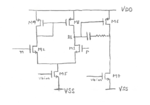flames4791
Junior Member level 3
Hi, I am trying to design a voltage summer and all of them require an opamp. I am having trouble understanding how the OpAmp can help the summer, especially when the sum of inputs is less than the voltage required to put the input transistors in saturation. I have designed a two stage single ended OpAmp with gain of about 40dB but when I connect it to the summer circuit it doesn't work. But when I put an ideal opamp from the Cadence library into the summer circuit with a gain of 100, the circuit works though. If anyone could give me some advice for how I can realize the summer, that would be great. Thank you!

